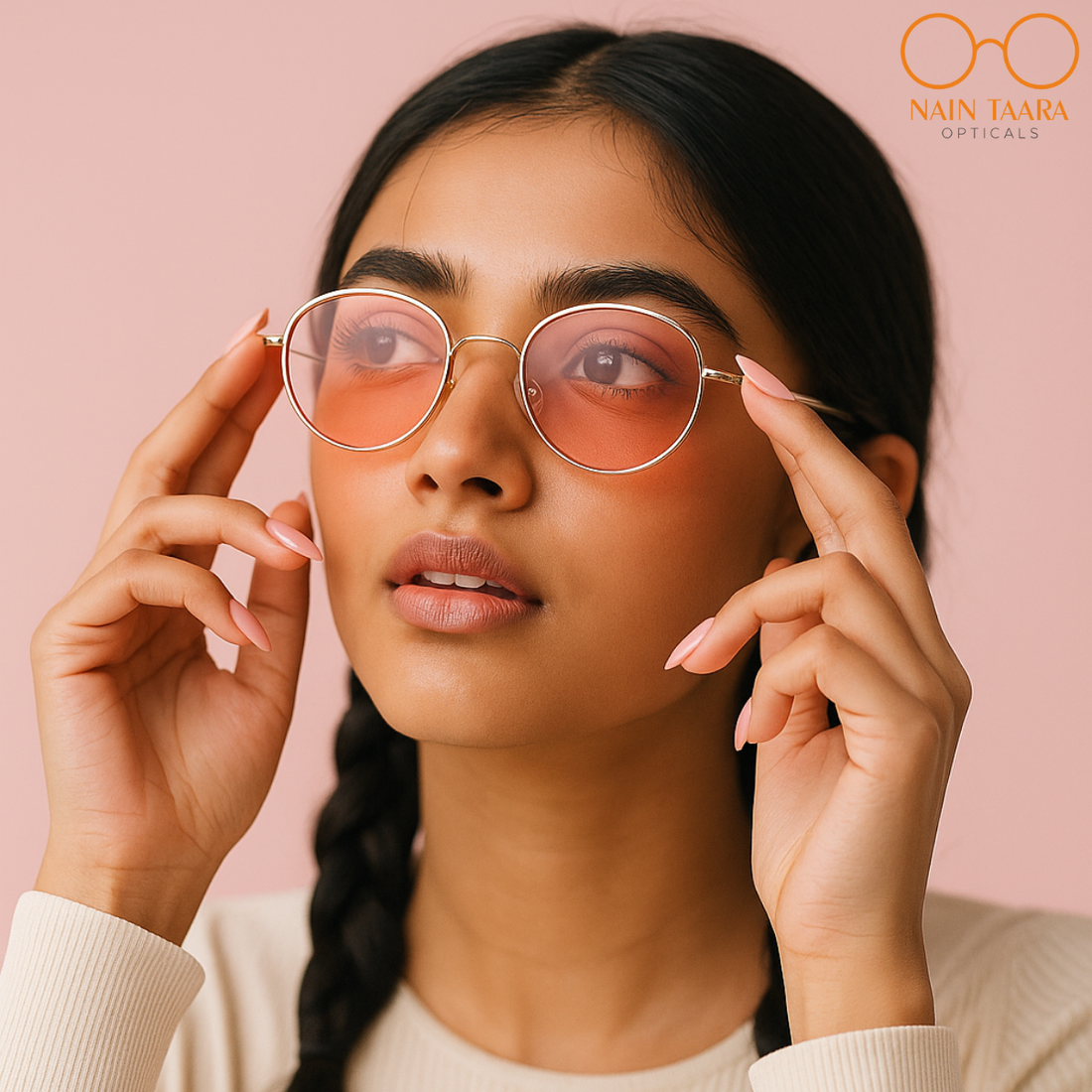
Share
often accompanied by photophobia, or intense sensitivity to light. In fact, research shows that 80–90% of migraine patients experience photophobia during attacks.
One under-discussed but well-researched tool for relief is rose-pink tinted eyewear, especially lenses with 20–25% visible transparency. These aren’t just fashionable glasses; they’re based on solid clinical science. 
How Rose Tint Eases Migraine
The key is a specialty filter known as FL-41. This rose-pink tint selectively blocks specific blue-green wave lengthsound 480 nm that are strongly linked to migraine activation.
Blue light from fluorescent bulbs, LED screens, and sunlight overstimulates the retina and visual cortex.
Filtering those wavelengths reduces the “hyper-excitable” brain activity that can trigger or worsen a migraine.
Blue light from fluorescent bulbs, LED screens, and sunlight overstimulates the retina and visual cortex.
Filtering those wavelengths reduces the “hyper-excitable” brain activity that can trigger or worsen a migraine.
Because a 20–25% tint is relatively light, wearers can comfortably use these lenses indoors, at the office, or while working on screens where migraine triggers often lurk.

Clinical Evidence at a Glance
The therapeutic benefits of rose-tinted lenses aren’t anecdotal. They’re well documented in peer-reviewed studies:
Seminal Study (Good et al., 1991, Cephalalgia)
Twenty children who wore FL-41 rose-tinted glasses for four months saw their average migraine frequency drop from about six per month to fewer than two.
Follow-Up Trials (Wilkins et al., 2002; Huang et al., 2011)
Adults using FL-41 lenses reported up to a 74% reduction in migraine days compared with control tints.
Functional MRI Findings (University of Utah, 2016)
Brain imaging showed that FL-41 lenses dampen hyperactivity in the visual cortex, offering a neurological explanation for patient relief.
These results have been replicated across diverse age groups and clinical settings.
The therapeutic benefits of rose-tinted lenses aren’t anecdotal. They’re well documented in peer-reviewed studies:
Seminal Study (Good et al., 1991, Cephalalgia)
Twenty children who wore FL-41 rose-tinted glasses for four months saw their average migraine frequency drop from about six per month to fewer than two.
Follow-Up Trials (Wilkins et al., 2002; Huang et al., 2011)
Adults using FL-41 lenses reported up to a 74% reduction in migraine days compared with control tints.
Functional MRI Findings (University of Utah, 2016)
Brain imaging showed that FL-41 lenses dampen hyperactivity in the visual cortex, offering a neurological explanation for patient relief.
These results have been replicated across diverse age groups and clinical settings.
Why 20–25% Transparency Hits the Sweet Spot
Tint density matters. Too dark, and indoor vision feels gloomy; too light, and the filter effect weakens.
A 20–25% visible light transmission provides an optimal balance:
Sufficient filtration of migraine-provoking blue/green light
Comfortable, natural vision for daily tasks
No “sunglasses indoors” look or eye strain from overly dark lenses
This makes the tint practical for all-day wear, including office environments and long hours at a computer.
Tint density matters. Too dark, and indoor vision feels gloomy; too light, and the filter effect weakens.
A 20–25% visible light transmission provides an optimal balance:
Sufficient filtration of migraine-provoking blue/green light
Comfortable, natural vision for daily tasks
No “sunglasses indoors” look or eye strain from overly dark lenses
This makes the tint practical for all-day wear, including office environments and long hours at a computer.
Everyday Benefits Beyond Migraine
- Many wearers report broader gains:
- Reduced digital eye strain during long screen sessions
- Better tolerance of harsh fluorescent lighting
- Improved comfort under variable outdoor light, such as cloudy days when traditional sunglasses feel too dark
1. Seek FL-41 or Equivalent Tints
Ask your optician or optical brand specifically for FL-41 or clinically comparable rose tints.
2. Request the Correct Transmission
Specify a 20–25% visible light transmission for indoor and mixed-light use.
3. Pair With Your Prescription (if needed)
The tint can be added to prescription lenses, blue-light filters, or even progressive lenses.

Key Takeaway
For migraine sufferers, especially those struggling with light sensitivity, rose-pink FL-41 lenses at 20–25% transparency offer a proven, drug-free way to reduce attack frequency and severity.
Far from a fashion trend, these lenses are a practical example of how optical science can improve neurological health.
Selected References & Further Reading
Good PA, Taylor RH, Mortimer MJ. Cephalalgia. 1991 – Pioneering pediatric FL-41 study
Wilkins AJ et al. Vision Research. 2002 – Tinted lenses and cortical hyperexcitability
Huang J et al. Cephalalgia. 2011 – FL-41 vs. gray lenses migraine reduction
Pacific Neuroscience Institute – Clinical guidance on light sensitivity and migraines
Migraine Disorders Foundation – Patient resources and clinical summaries
Thera Specs Research Library – Compiled peer-reviewed FL-41 data
For migraine sufferers, especially those struggling with light sensitivity, rose-pink FL-41 lenses at 20–25% transparency offer a proven, drug-free way to reduce attack frequency and severity.
Far from a fashion trend, these lenses are a practical example of how optical science can improve neurological health.
Selected References & Further Reading
Good PA, Taylor RH, Mortimer MJ. Cephalalgia. 1991 – Pioneering pediatric FL-41 study
Wilkins AJ et al. Vision Research. 2002 – Tinted lenses and cortical hyperexcitability
Huang J et al. Cephalalgia. 2011 – FL-41 vs. gray lenses migraine reduction
Pacific Neuroscience Institute – Clinical guidance on light sensitivity and migraines
Migraine Disorders Foundation – Patient resources and clinical summaries
Thera Specs Research Library – Compiled peer-reviewed FL-41 data
Final Thought
Migraines cost billions in lost productivity each year and erode quality of life for millions. Sometimes, the simplest innovations like a subtle rose-pink lens-can make the most meaningful difference.
We’ll be back soon with insights on a new specialty tint and the unique benefits it offers-stay tuned!
Migraines cost billions in lost productivity each year and erode quality of life for millions. Sometimes, the simplest innovations like a subtle rose-pink lens-can make the most meaningful difference.
We’ll be back soon with insights on a new specialty tint and the unique benefits it offers-stay tuned!
